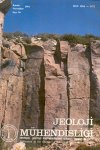
ABSTRACT: In this article several geological features and hydrocarbon potentials of some sedimentary basins located in different regions, in Türkiye are reevaluated in the light of recent, ideas and developments.
ABSTRACT: Secondary porosity play an important role in the diagenesis of some santstones. Studies after 1970`s have shown that more than half of the porosity in sandstones is secondary in origin. Chemical. Physicochemical, biochemical, physical, and biophysical presses result in secondary porosity through, leaching and shrinkage of rock constituents or through the opening and shrinkage of rock constituents or through the opening of fractures.. Secondary prosity can originate anywhere in the diagenetic history.. Most of secondary prosity in ancient sandstones formed as a result of mesogenetic leaching of the carbonate minerals such as calcite, dolamite and siderite. Secondary porosity resulting from, the dissolution of unstable framework or cement» such as feldspar, carbonate, sulfate or rock fragment is common in sandstone. Recognition, of secondary porosity should be based on multiple evidence because monfractured secondary porosity often mimics primary porosity.. Pétrographie criteria for recognizing secondary porosity Include partial dissolution, molds, inomogeneus packing, oversized pores, carrodedr grains, intraconstltuent pores and fractured grains.
ABSTRACT: The Ulukışla-Çamardı basin is bordered by .Niğde group in the north, Bolkar group in the south, and Ecemiş fault in the east The basin is divided into three sections in terms of stratigraphy and lithology. The purpose of this study is to illustrate the genesis, mechanisms, mineralogies and deposit properties of extensive mineralizations in the studied area., As a result of investigations,,, main mineralizations, some of them are of economic interest, related to magmatisxn resulted from continent-continent collision are Karıncadağı Pb-Zn-Cu, Alkoyağı dere Co, Karnıoğlu Fe-Cu, Esendemir tepe Fe-Co-Cu, Uçurum tepe Cu, Cipcip dere Fe-Cu, Kayserilinin dere Cu and Yağlıtaş Pb-Cu
ABSTRACT: A Pliocene aged, geological unit, which is mostly reddish brown colored, crops out at many places around the Ankara city,. Many geographical locations over the unit are called, with a prefix "kızıl" denoting the characteristic .reddish brown color of the. unit. Therefore the unit is named as Kızıl formation (Plk). There are two common suggestions about the depositional environment of the Plk; Pik has been deposited by meandering and. braided, rivers. Plk has deposited in intermountain basins (ponds-lakes). In order to gather geological data, and to find, more evidences,, six distinguishable Pliocene Basins, around Ankara were studied. Identification of the PIk`s depositional environment in datait, can. provide valuable information to implement effective investigation, methods to carry out geotechnical properties of the Plk at any study .area in this unit., Naturally» engineering properli.es of the unit depends mainly upon the position and. location of any delineated site. Grain, size, composition, thickness of layers, areal extent, interested depth, distance, from paleoshore, and. catchment, area properties, are main factors which control geotechnical properties of the unit at a given site. The Plk has deposited over a hummocky topography. Its basal level elevation on the same line along short axis of Hatip ovası basin, changes from > 1200 m to < 700 m. It consists mainly of sedimentary breccia, conglomerate, and sandstone along border zone whereas siltstone, muds tone, and claystone along longitudinal axis of basins.. Sorting from shore to the deepest part is quite common in the Pliocene basins .around Ankara.Main cement type in the unit is CH clay Consequently rock structure breaks easily and partly turns into soil where it has been fully saturated for long period.However bedding planes remain distinct. This situation is observable mainly along long axes of basins Moderately weak to moderately strong sedimentary rocks, along border zone, gradual ly transits into extremely weak sedimentary rocks toward the deepest part of a basin In addition to the high CH clay content and saturation,, stress relief is well effective on engineering properties of the unit. Therefore the uppermost level of the unit, especially over a gently sloping and .relatively wide area whichs includes thick pebbly soil mantle derived from the Plk, is called Pebbly soil member (Plkp).Evaluation of numereous field investigation and laboratory works support basically the second suggestion which says that the Plk. has deposited, in intermountain basins. It is difficult to find geological, evidences to support, the proposal saying the Plk has formed as stream, deposits.
ABSTRACT: In this study the significance of subsurface temperature and geothermal gradient wells are briefly evaluated lor geothermal energy exploration. The world average geothermal gradient is considered to be 25°C/km. Thermal conductivity of rocks strata, regional, heat flow conditions, subsurface- thermal water moment, and global tectonic phanoraena are controlling` for geothermal gradient. Some extraneous factors that affect shallow depth temperatures (1-15 meter) are local, variations in the character and moisture content of the near surface materials, topography, depth to water table, vegetation, and microclimate,, so that. shallow température, distributions are not enough to provide economically usable thermal fluids. The principal advantage of temperature measurements at such, shallow depths in comparison, with deeper measurements are their relatively lowcost in both time and money
ABSTRACT: In this paper, general properties, occurence, fields of usage of wollastonite which gained its popularity after 1950Ts are introdudeced and its economic importance are summarized with the examples given from, various countries and Turkey.The `aim of this paper is to provide an. introductory review on wollastonite to contribute towards studies related to wollastonite

 TMMOB
TMMOB